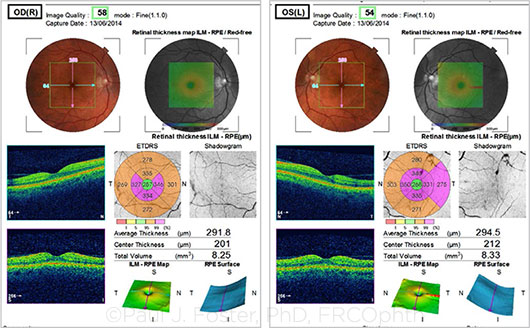Download PDF
The list of failed drug trials for Alzheimer disease (AD) is lengthy and continues to grow, mainly because patients receiving treatment have an advanced case of the disease. Early detection is, therefore, key to finding a cure. But can an eye screening test help identify risk? A team of U.K. researchers explored the connection between the retina and dementia and found that a thin retinal nerve fiber layer (RNFL) might indicate future cognitive decline.1
The association. UK Biobank is a multicenter, community-based study of more than 30,000 U.K. residents aged 40 to 69 years. At enrollment, participants underwent optical coherence tomography (OCT) imaging, a physical examination, and cognitive testing. The research team found that worse cognitive performance was associated with a thinner RNFL at baseline, and those in the thinnest quintile of RNFLs were 11% more likely to fail at least 1 cognitive test. In addition, participants with an RNFL thickness in the 2 thinnest quintiles were almost twice as likely to have at least 1 test score be worse at follow-up.
 |
BIOMARKER. This OCT map shows a thin RNFL, a potential red flag for dementia.
|
Treatment implications. “Our findings suggest the retinal abnormalities that are identifiable in established dementia begin to manifest in the early stages of cognitive decline,” said coauthor Paul J. Foster, PhD, FRCOphth, at Moorfields Eye Hospital and UCL Institute of Ophthalmology in London. And the earlier the detection, the better, he added. “Between 2002 and 2012, 99% of clinical trials of treatments for AD failed. A probable reason for this failure rate is that treatments are being provided to those patients who already have irreparable damage to the brain. By targeting people in the very early stages of cognitive change, it should be possible to design better clinical trials for treatments” that slow or stop further onset.
Supporting evidence. Similar results emerged in a Dutch study that explored the link between retinal neurodegeneration and dementia.2 In the more than 5,000 study participants, OCT imaging showed that thinner ganglion cell–inner plexiform layers were associated with existing dementia, while thinner RNFLs were associated with an increased risk of developing dementia.
Taken together, these 2 studies suggest that retinal abnormalities—and possibly other ocular characteristics—may serve as unique preclinical biomarkers for dementia, specifically for AD. For clinicians and researchers, this could present an opportunity in the future to use OCT as an accessible and noninvasive tool to help monitor disease progression, evaluate treatment response, and shape eligibility determination for future clinical trials.
—Michael Mott
___________________________
1 Ko F et al. JAMA Neurol. Published online June 25, 2018.
2 Mutlu U et al. JAMA Neurol. Published online June 25, 2018.
___________________________
Relevant financial disclosures—Dr. Foster: None.
For full disclosures and the disclosure key, see below.
Full Financial Disclosures
Dr. Chévez-Barrios NASA: S.
Dr. Foster None.
Dr. Khawaja Allergan: C,L; Grafton Optical: L; Novartis: C; Thea: C.
Dr. Wirostko EyeGate: E;O.
Disclosure Category
|
Code
|
Description
|
| Consultant/Advisor |
C |
Consultant fee, paid advisory boards, or fees for attending a meeting. |
| Employee |
E |
Employed by a commercial company. |
| Speakers bureau |
L |
Lecture fees or honoraria, travel fees or reimbursements when speaking at the invitation of a commercial company. |
| Equity owner |
O |
Equity ownership/stock options in publicly or privately traded firms, excluding mutual funds. |
| Patents/Royalty |
P |
Patents and/or royalties for intellectual property. |
| Grant support |
S |
Grant support or other financial support to the investigator from all sources, including research support from government agencies (e.g., NIH), foundations, device manufacturers, and/or pharmaceutical companies. |
|
More from this month’s News in Review